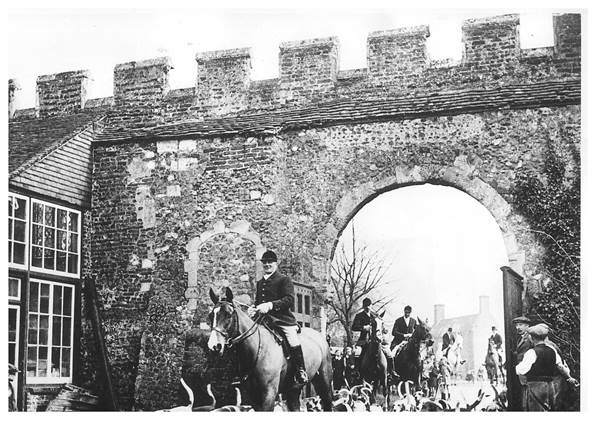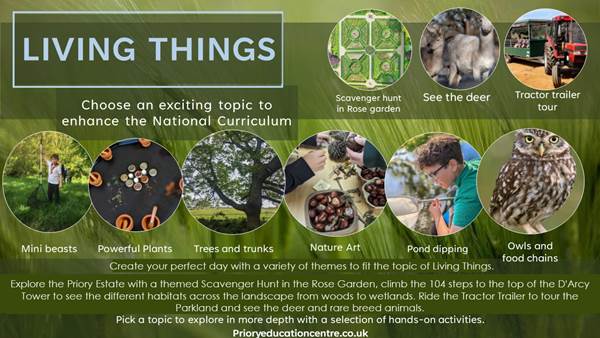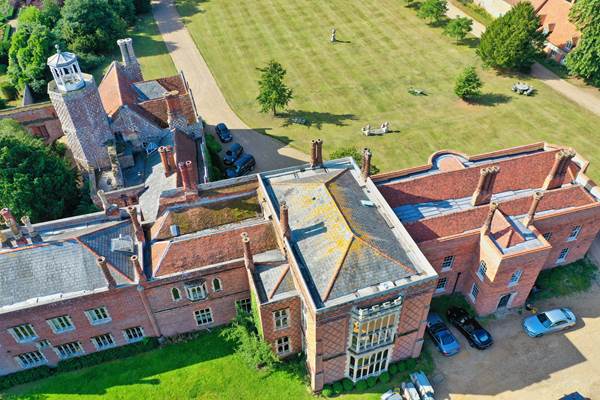School Trips
From the chance to catch a glimpse of our magical white deer to a historic house steeped in tales of the past, St Osyth Priory offers students a memorable and inspiring curriculum-linked learning experience.
Each school visit programme has been created to enhance classroom learning, strengthen core literacy and numeracy skills, and equip students with an increased sense of knowledge, curiosity and wonder about topics ranging from the Vikings to natural habitats.
Explore a wealth of online education resources designed to help students acquire new and transferable skills or select the perfect itinerary for your class from our programme of activities and events.
All of our programmes
Vikings v. Anglo Saxons! Explores a moment of high drama at St Osyth Priory: the beheading of Osyth by the Vikings.
Looking out over the Essex coastline from the top of the Darcy Tower students learn about the Vikings and get a bird's-eye view of their route towards the Anglo Saxon nunnery which once stood on the Estate. Children run free in the Victorian rose garden piecing together a scavenger hunt of clues which helps them to unlock the mysterious legend of St Osyth before they step inside the Medieval chapel where the monks dedicated their lives to the Anglo Saxon saint.
There are, however, two sides to every story, so students also hear from a Viking about the harsh realities of life in Scandinavia. This leads us to ponder, who deserves our sympathy: the Vikings forced to leave their homes in search of a better life, or the Anglo Saxons who were confronted by these terrifying raiders?
There's only one way to settle this and fortunately it doesn't involve a battle-axe! Children learn the basics of competitive debating so that they can fight it out verbally and decide whether 'this house believes we should pity the Vikings.'
VIKINGS V. ANGLO SAXONS

Key Details
Vikings v. Anglo Saxons! Explores a moment of high drama at St Osyth Priory: the beheading of Osyth by the Vikings.
Looking out over the Essex coastline from the top of the Darcy Tower students learn about the Vikings and get a bird's-eye view of their route towards the Anglo Saxon nunnery which once stood on the Estate. Children run free in the Victorian rose garden piecing together a scavenger hunt of clues which helps them to unlock the mysterious legend of St Osyth before they step inside the Medieval chapel where the monks dedicated their lives to the Anglo Saxon saint.
There are, however, two sides to every story, so students also hear from a Viking about the harsh realities of life in Scandinavia. This leads us to ponder, who deserves our sympathy: the Vikings forced to leave their homes in search of a better life, or the Anglo Saxons who were confronted by these terrifying raiders?
There's only one way to settle this and fortunately it doesn't involve a battle-axe! Children learn the basics of competitive debating so that they can fight it out verbally and decide whether 'this house believes we should pity the Vikings.'
Programme Timings
10am – 2pm, Tuesdays, Wednesdays and Thursdays during term time
Price
£7.50 per student, no charge for teachers and accompanying adults
KS2 Links
The Viking and Anglo-Saxon struggle for the Kingdom of England to the time of Edward the Confessor: Viking Raids and Invasion
Britain’s settlement by Anglo-Saxons and Scots: Christian conversion
Resources
This hands-on sensory programme is an ideal way to introduce students to the Medieval era, medical history and the plague.
An immersive and atmospheric learning experience set in the beautiful Medieval chapel at St Osyth Priory gives students the opportunity to find out more about the monks who lived there, providing medical care to their community.
Working with herbs from the Priory Education Centre’s Medieval herb garden students gain an understanding of the real and imagined medicinal properties of herbs as well as their preparation and use in Medieval, Tudor and modern medicine.
Students will also have chance to explore the stunning grounds of the Priory Estate and learn the legend of its namesake St Osyth.
MEDIEVAL MEDICINE

Key Details
This hands-on sensory programme is an ideal way to introduce students to the Medieval era, medical history and the plague.
An immersive and atmospheric learning experience set in the beautiful Medieval chapel at St Osyth Priory gives students the opportunity to find out more about the monks who lived there, providing medical care to their community.
Working with herbs from the Priory Education Centre’s Medieval herb garden students gain an understanding of the real and imagined medicinal properties of herbs as well as their preparation and use in Medieval, Tudor and modern medicine.
Students will also have chance to explore the stunning grounds of the Priory Estate and learn the legend of its namesake St Osyth.
Programme Timings
10am – 2pm, Tuesdays, Wednesdays and Thursdays during term time
Price
£7.50 per student, no charge for teachers and accompanying adults
KS1 Links
History: Events beyond living memory that are significant nationally
KS2 Links
Science: Animals including humans: Recognise the impact of drugs on the way their bodies function
Working scientifically: Identifying scientific evidence that has been used to support or refute ideas or arguments.
KS3 Links
History: The development of Church, state and society in Medieval Britain 1066-1509: The Black Death and its social and economic impact
St Osyth Priory was at the centre of an intense power struggle involving Henry VIII, Thomas Cromwell and Thomas Audley after England broke with the Catholic church in Rome. Its story and history reflect the seismic changes that England underwent during this tumultuous period of Tudor rule, and give students the chance to understand the impact these changes had on the local community.
This programme traces the dissolution of the monastery at St Osyth through a numeracy and drama-based workshop in which students act out the roles of auditors and monks to estimate the value of treasures, land, and property seized by Henry VIII’s men. The dissolution represents the single largest transfer of wealth in English history since 1066 and students will consider what this meant for those in the village of St Osyth and the wider area who depended on the monastery for work, education and medical care.
A walking tour will take in the remaining Medieval monastic buildings on the Estate which were spared ruin, including the chapel which we will visit. There students will find out about the role St Osyth Priory played in the fate of the King’s favourite Lord Thomas Cromwell. The class will have a chance to meet the Estate’s herd or rare white deer and while at the deer park they learn of a secret Tudor love poem about a white deer written to one of the King’s wives.
TUDORS: WEALTH, GREED, SCANDAL AND POWER

Key Details
St Osyth Priory was at the centre of an intense power struggle involving Henry VIII, Thomas Cromwell and Thomas Audley after England broke with the Catholic church in Rome. Its story and history reflect the seismic changes that England underwent during this tumultuous period of Tudor rule, and give students the chance to understand the impact these changes had on the local community.
This programme traces the dissolution of the monastery at St Osyth through a numeracy and drama-based workshop in which students act out the roles of auditors and monks to estimate the value of treasures, land, and property seized by Henry VIII’s men. The dissolution represents the single largest transfer of wealth in English history since 1066 and students will consider what this meant for those in the village of St Osyth and the wider area who depended on the monastery for work, education and medical care.
A walking tour will take in the remaining Medieval monastic buildings on the Estate which were spared ruin, including the chapel which we will visit. There students will find out about the role St Osyth Priory played in the fate of the King’s favourite Lord Thomas Cromwell. The class will have a chance to meet the Estate’s herd or rare white deer and while at the deer park they learn of a secret Tudor love poem about a white deer written to one of the King’s wives.
Programme Timings
10am – 2pm, Tuesdays, Wednesdays and Thursdays during term time
Price
£7.50 per student, no charge for teachers and accompanying adults
KS2 Links
A local history study.
A significant turning point in British history: a study of an aspect or theme in British history that extends pupils’ chronological knowledge beyond 1066
KS3 Links
The development of Church, state and society in Britain 1509-1745: the English Reformation and Counter-Reformation (Henry VIII to Mary I)
Local History Study: a study over time, testing how far sites in their locality reflect aspects of national history
Every visit will include a scavenger hunt around the Victorian Rose Garden linked to your chosen theme or the origin story of St. Osyth Priory. Children can climb the 104 steps to the top of the Darcy Tower to survey the landscape and different habitats in the area; woodland, meadow, coast, and wetland (Key Stage 2 children and above). Children will take a ride on the Tractor Trailer to spot the variety of wild animals and birds as well as see our 2 herds of deer and rare breed farm animals.
In addition, choose from one of the following topics, each includes something to make and do to take back to the classroom.
Pond Dipping. Join us at the edge of Seal Pond to find out what lives in its peaceful waters. Students will dip their nets into the water and then use scientific keys to identify the vertebrates and invertebrates they have found. They will also learn how to check and evaluate the pond’s health as a habitat. Learning activity focusing on Lifecycles: dragonfly and damselfly are both found around and in (nymphs) the pond and this activity helps students to understand their fascinating lifecycle.
Owls and birds. Look at the seasonal nesting habits of bird species found at St Osyth Priory, examining food chain and habitat threats to owl and bird species. Dissect an owl pellet.
Marvelous Mini beasts. Use meadow sweeping and sheet collection techniques to survey mini beasts. Use flow charts to aid identification and classification of different insets.
Natural Art. Discover the works of artists such as Andy Goldworthy and Richard Long and use the nature and beautiful environment of the Estate to create your own works of art.
Powerful Plants. Learn about the power of plants, particularly those used in medicine. identify and collect plants form the Estate and discover their uses. Create a pomander using these plants to take home.
Trees and trunks. Trees from the Estate have been used for timber to create Henry VIIIs navy and we have a large variety of native and non-native species. You will learn some tree identification skills and use measuring tapes to age different trees on the Estate.
LIVING THINGS

Key Details
Every visit will include a scavenger hunt around the Victorian Rose Garden linked to your chosen theme or the origin story of St. Osyth Priory. Children can climb the 104 steps to the top of the Darcy Tower to survey the landscape and different habitats in the area; woodland, meadow, coast, and wetland (Key Stage 2 children and above). Children will take a ride on the Tractor Trailer to spot the variety of wild animals and birds as well as see our 2 herds of deer and rare breed farm animals.
In addition, choose from one of the following topics, each includes something to make and do to take back to the classroom.
Pond Dipping. Join us at the edge of Seal Pond to find out what lives in its peaceful waters. Students will dip their nets into the water and then use scientific keys to identify the vertebrates and invertebrates they have found. They will also learn how to check and evaluate the pond’s health as a habitat. Learning activity focusing on Lifecycles: dragonfly and damselfly are both found around and in (nymphs) the pond and this activity helps students to understand their fascinating lifecycle.
Owls and birds. Look at the seasonal nesting habits of bird species found at St Osyth Priory, examining food chain and habitat threats to owl and bird species. Dissect an owl pellet.
Marvelous Mini beasts. Use meadow sweeping and sheet collection techniques to survey mini beasts. Use flow charts to aid identification and classification of different insets.
Natural Art. Discover the works of artists such as Andy Goldworthy and Richard Long and use the nature and beautiful environment of the Estate to create your own works of art.
Powerful Plants. Learn about the power of plants, particularly those used in medicine. identify and collect plants form the Estate and discover their uses. Create a pomander using these plants to take home.
Trees and trunks. Trees from the Estate have been used for timber to create Henry VIIIs navy and we have a large variety of native and non-native species. You will learn some tree identification skills and use measuring tapes to age different trees on the Estate.
Programme Timings
10am – 2pm, Tuesdays, Wednesdays and Thursdays during term time
Price
£7.50 per student, no charge for teachers and accompanying adults
KS1 Links
Working scientifically: Animals, seasonal change, living things and their habitats
Maths: Recognise and draw shapes, using measuring tools
Design Technology: Select from and use a range of tools and equipment to perform practical tasks
KS2 Links
Working scientifically: Animals, seasonal change, living things and their habitats
Maths: Problem solving, using measuring instruments with accuracy and make connections between measure and number
Design Technology: Select from and use a range of tools and equipment to perform practical tasks accurately
KS3 Links
Relationships in an ecosystem
Enjoy a day out at a Tudor stately home and discover what daily life was like in the 16th Century.
Choose from an exciting menu of topics to create a bespoke day for your class.
Homes – explore the architectural features of a Tudor house and how these were a display of wealth. Children make their own model of the Darcy House to take home.
Clothes – England was founded on the wool trade. See the rare breed sheep, process and spin the fleece and learn about the importance of this trade in Tudor times.
Food – Discover the typical diet in Tudor times and how religion impacted what could be eaten. Option to fish for monastic carp in the Medieval pond and try dried eel.
Medicine - Disease was rife in Tudor times. Discover what they thought caused it and how they treated it. Make a pomander to take home to ward off any miasma.
Leisure – What did the Tudors do for fun? Play some typical Tudor games and make a toy to take back to the playground.
Shakespeare – Theatre was incredibly popular in Tudor times with the likes of Marlowe and Shakespeare. Enjoy a theatre workshop with a beautiful backdrop.
Religion – Spiritual life was central to Tudor life and this period saw more changes than any other. Discover what it was like to be a monk at St. Osyth Priory and the impact the religious changes had on the community. Includes dressing up as monks and nuns.
An option for children to wear Tudor dress, with full guidance given on how to utilise items to do this as easily and cheaply as possible. Education Centre staff will also look the part!
TUDOR CULTURE AND DAILY LIFE

Key Details
Enjoy a day out at a Tudor stately home and discover what daily life was like in the 16th Century.
Choose from an exciting menu of topics to create a bespoke day for your class.
Homes – explore the architectural features of a Tudor house and how these were a display of wealth. Children make their own model of the Darcy House to take home.
Clothes – England was founded on the wool trade. See the rare breed sheep, process and spin the fleece and learn about the importance of this trade in Tudor times.
Food – Discover the typical diet in Tudor times and how religion impacted what could be eaten. Option to fish for monastic carp in the Medieval pond and try dried eel.
Medicine - Disease was rife in Tudor times. Discover what they thought caused it and how they treated it. Make a pomander to take home to ward off any miasma.
Leisure – What did the Tudors do for fun? Play some typical Tudor games and make a toy to take back to the playground.
Shakespeare – Theatre was incredibly popular in Tudor times with the likes of Marlowe and Shakespeare. Enjoy a theatre workshop with a beautiful backdrop.
Religion – Spiritual life was central to Tudor life and this period saw more changes than any other. Discover what it was like to be a monk at St. Osyth Priory and the impact the religious changes had on the community. Includes dressing up as monks and nuns.
An option for children to wear Tudor dress, with full guidance given on how to utilise items to do this as easily and cheaply as possible. Education Centre staff will also look the part!
Programme Timings
10am-2pm
Price
£7.50 per student, no charge for teachers and accompanying adults
KS2 Links
Aimed at Key Stage 2 children but can be adapted to suit your needs.
